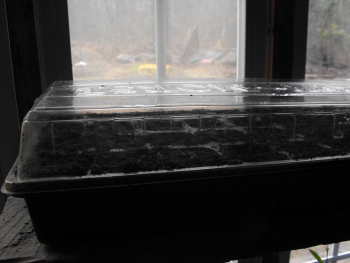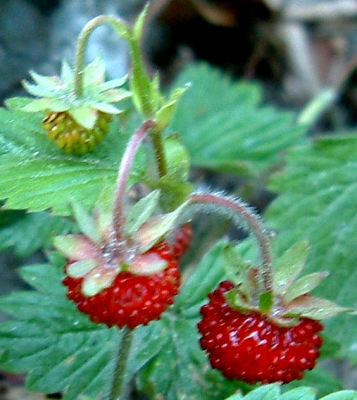
Starting alpine strawberries from seed
 Despite
swearing up and down that I wasn't going to start any seeds indoors
this year, I filled a flat with stump
dirt Monday and
sprinkled in tiny alpine strawberry seeds. I tossed a few in the
ground outdoors, too, as a control since I believe that plants people
baby indoors often do just as well when planted straight in the garden.
Despite
swearing up and down that I wasn't going to start any seeds indoors
this year, I filled a flat with stump
dirt Monday and
sprinkled in tiny alpine strawberry seeds. I tossed a few in the
ground outdoors, too, as a control since I believe that plants people
baby indoors often do just as well when planted straight in the garden.
I'm excited to add
alpine strawberries to our current repertoire of June-bearing and
everbearing strawberries. I've read that alpine strawberries can
cope with partial shade and make a good addition to the herb layer of forest
gardens. Plus,
the fruits are reputed to have the best flavor of all strawberries,
even though they're so tiny that you probably don't want to pick too
many. Best of all, alpine strawberries can be started from seed
as long as you do so indoors, which eliminates the high startup costs
of traditional strawberries.

This is our second shot
at starting strawberries from seed. We grew some our first year
on the farm, planting the seeds in the middle of January and eating
fruits by summer. Yields were good but, unfortunately, the
variety we grew (fresca) was some sort of odd hybrid with full-sized
berries that were quite tasteless.
In case you're a botany
geek like me, you might be interested to know that the various types of
strawberries are in different species. The big June-bearing
strawberries are Fragaria x ananassa, which is a hybrid between
the eastern North American native Fragaria
virginiana (which
grows wild in our woods) and the large-fruited, South American Fragaria
chiloensis.
Alpine strawberries were bred from Fragaria
vesca, a native
strawberry to parts of North America, Europe, and Asia. Although
we don't hear much about Alpine strawberries, they have been eaten
since the Stone Age and literal tons are still picked commercially each
year in Turkey. I look forward to picking our own this summer!
Want more in-depth information? Browse through our books.
Or explore more posts by date or by subject.
About us: Anna Hess and Mark Hamilton spent over a decade living self-sufficiently in the mountains of Virginia before moving north to start over from scratch in the foothills of Ohio. They've experimented with permaculture, no-till gardening, trailersteading, home-based microbusinesses and much more, writing about their adventures in both blogs and books.
Want to be notified when new comments are posted on this page? Click on the RSS button after you add a comment to subscribe to the comment feed, or simply check the box beside "email replies to me" while writing your comment.

Anonymous --- I agree that they look like Indian Strawberry fruits. But the flowers are white, not yellow, and I hear the fruits are much, much tastier.
Daddy --- sunlight is often important for fruit coloration --- I've seen a trick where you take a piece of scotch tape and write your name on it with an indelible marker and put the tape on an apple when it's full size but green. When the apple has turned red, take off the tape and your name will be there in green --- without sun, it didn't change color. I can't help but wonder whether your half white strawberries just didn't get enough light in the shade and thus stayed white. That said, I've read that there are a few varieties of alpine strawberries that stay white.